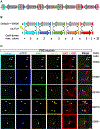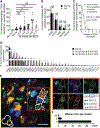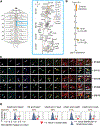Identification of Neuronal Lineages in the Drosophila Peripheral Nervous System with a "Digital" Multi-spectral Lineage Tracing System
- PMID: 31801091
- PMCID: PMC6913890
- DOI: 10.1016/j.celrep.2019.10.124
Identification of Neuronal Lineages in the Drosophila Peripheral Nervous System with a "Digital" Multi-spectral Lineage Tracing System
Abstract
Elucidating cell lineages provides crucial understanding of development. Recently developed sequencing-based techniques enhance the scale of lineage tracing but eliminate the spatial information offered by conventional approaches. Multi-spectral labeling techniques, such as Brainbow, have the potential to identify lineage-related cells in situ. Here, we report nuclear Bitbow (nBitbow), a "digital" version of Brainbow that greatly expands the color diversity for scoring cells, and a suite of statistical methods for quantifying the lineage relationship of any two cells. Applying these tools to the Drosophila peripheral nervous system (PNS), we determined lineage relationship between all neuronal pairs. This study demonstrates nBitbow as an efficient tool for in situ lineage mapping, and the complete lineage relationship among larval PNS neurons opens new possibilities for studying how neurons gain specific features and circuit connectivity.
Keywords: Bitbow; Brainbow; Drosophila; development; lineage tracing; multi-spectral labeling; peripheral nervous system; statistics.
Copyright © 2019 The Author(s). Published by Elsevier Inc. All rights reserved.
Conflict of interest statement
DECLARATION OF INTERESTS
The authors declare no competing interests.
Figures





References
-
- Ai HW, Hazelwood KL, Davidson MW, and Campbell RE (2008). Fluorescent protein FRET pairs for ratiometric imaging of dual biosensors. Nat. Methods 5, 401–403. - PubMed
-
- Benjamini Y, and Hochberg Y (1995). Controlling the False Discovery Rate—a Practical and Powerful Approach to Multiple Testing. J. R. Stat. Soc. B 57, 289–300.
Publication types
MeSH terms
Grants and funding
LinkOut - more resources
Full Text Sources
Molecular Biology Databases
Research Materials

